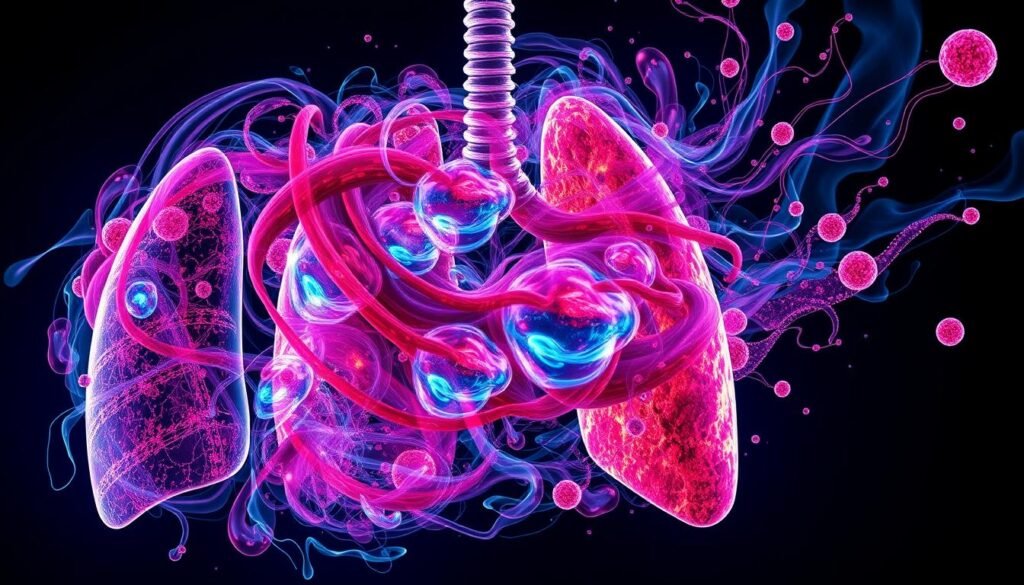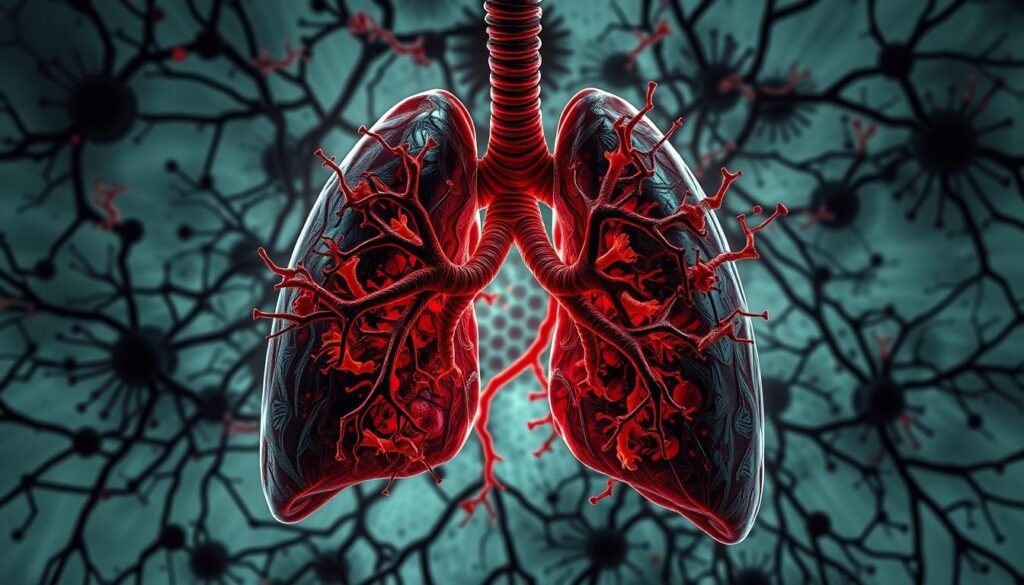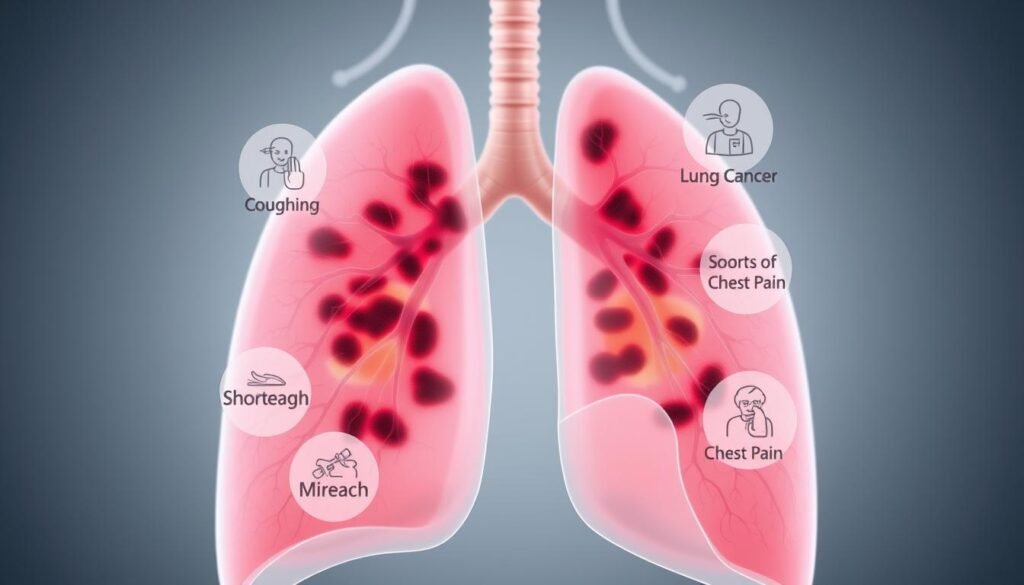Did you know small cell lung cancer (SCLC) makes up about 15% of lung cancer cases? Yet, it’s the most aggressive kind. This stat shows us how serious and quickly SCLC can grow, mostly because of cigarette smoking. As more people get lung cancer, it’s key to know the different types for better treatment and care.
This article talks about lung cancer, especially SCLC and non-small cell lung cancer (NSCLC). These two are the main kinds of lung cancer. Each one needs its own way to treat and care for it. We will look at what makes them different, what risks they bring, and how to treat them. This info helps people manage their health against this tough disease.
Key Takeaways
- Small cell lung cancer is the most aggressive form of lung cancer.
- Comprising about 15% of all lung cancer cases, SCLC grows rapidly and spreads quickly.
- Almost all cases of SCLC are linked to smoking.
- Early diagnosis is rare, with most cases discovered after the cancer has metastasized.
- Survival rates for patients diagnosed with SCLC are significantly low.
- Radiation therapy is often combined with chemotherapy in treatment plans for SCLC.
Understanding Lung Cancer
Lung cancer is a major health concern in the U.S., ranking third after breast and prostate cancer. Every year, around 235,000 Americans are diagnosed with lung cancer. About 611,000 people are currently fighting this disease. It’s crucial to know about lung cancer to raise awareness.
What is Lung Cancer?
Lung cancer starts in the lungs, mainly affecting the bronchi or lung tissue. There are two main kinds: non-small cell lung cancer (NSCLC) and small cell lung cancer (SCLC). NSCLC is the most common, making up 85% to 90% of all lung cancers. SCLC represents about 10% to 15% and is more aggressive.
Smoking is the leading cause of lung cancer, linked to up to 90% of cases. Interestingly, 60% of people with lung cancer have quit smoking. Even secondhand smoke exposure causes thousands of lung cancer cases annually.
Lung cancer is often found by accident, during chest X-rays for other issues. Understanding the different lung cancer types is key for treatment and management. Staging the cancer is important. It helps doctors choose treatments and assess how far the disease has spread.
For more info, a detailed lung cancer overview is helpful. Knowing about lung cancer types, features, and treatments supports healthy decisions. It also boosts efforts to combat this disease.
Types of Lung Cancer
Lung cancer is mainly split into two types: Non-Small Cell Lung Cancer (NSCLC) and Small Cell Lung Cancer (SCLC). Each kind has unique traits that affect therapy and outlook. Knowing these types helps us understand the disease and its effects on people.
Small Cell Lung Cancer Versus Non-Small Cell Lung Cancer
NSCLC makes up about 80 to 85 percent of lung cancer cases. This type is further broken down into three subtypes:
- Adenocarcinoma
- Squamous cell carcinoma
- Large cell carcinoma
Adenocarcinoma is the most common NSCLC subtype, followed by squamous cell carcinoma. Large cell carcinoma is rare in this group.
In comparison, SCLC is rarer and more aggressive. It spreads faster than NSCLC and is often found at a late stage. This makes treating it harder.
Both SCLC and NSCLC need specific treatment plans. These plans are based on their different biological and clinical features.
| Type of Lung Cancer | Prevalence | Main Subtypes | Aggressiveness |
|---|---|---|---|
| Non-Small Cell Lung Cancer (NSCLC) | 80-85% of cases | Adenocarcinoma, Squamous cell carcinoma, Large cell carcinoma | Moderate |
| Small Cell Lung Cancer (SCLC) | 15-20% of cases | Small cell carcinoma, Combined small cell carcinoma | High |
https://www.youtube.com/watch?v=ihCnDjyJv5c
Small Cell Lung Cancer: The Most Aggressive Form
Small cell lung cancer (SCLC) is known for being highly aggressive. It usually starts in the bronchi and grows quickly. It spreads fast to lymph nodes and other organs. Detecting it early is crucial, but sadly, it’s often found after it has already spread.
About 15% of all lung cancer cases are SCLC. Sadly, the outlook for these patients is not good. Most live less than a year after diagnosis. This shows why finding effective SCLC treatment quickly is so critical.
One treatment option is TECENTRIQ, especially for extensive-stage SCLC. It’s used with carboplatin and etoposide. However, this treatment can have tough side effects. These may include severe problems with the immune system. Doctors need to watch patients closely for these issues.
Even with new treatments, the fight against SCLC is tough. It needs fast and careful treatment management. This is due to its aggressive nature.
| Drug | FDA Approval Date | Indication |
|---|---|---|
| TECENTRIQ | Not specified | Treatment for adults with small cell lung cancer |
| Etoposide | 01/01/1983 | Primary drug for treating SCLC |
| Carboplatin (Paraplatin) | 01/01/1989 | Used for SCLC and NSCLC |
| Nivolumab (Opdivo) | 08/01/2018 | Combination therapy for metastasized SCLC |
| Pembrolizumab (Keytruda) | 03/01/2020 | After platinum chemotherapy and one additional therapy for metastasized SCLC |
| Lurbinectedin (Zepzelca) | 12/10/2024 | For metastatic SCLC under Accelerated Approval Program |
| Topotecan Hydrochloride (Hycamtin) | 01/01/1996 | For SCLC following disease progression |
Characteristics of Small Cell Lung Cancer
Small cell lung cancer (SCLC) stands out due to its aggressive nature. It makes up about 15% of all lung cancer cases in the United States. Each year, more than 200,000 new cases are found. Smoking is the main cause of this cancer, responsible for around 85% of these cases.
SCLC comes in two main types: classic and combined small cell carcinoma. Early on, symptoms may be unclear but soon lead to a constant cough, chest pain, and trouble breathing. These signs show how quickly the cancer grows. It’s vital to catch and diagnose SCLC early. Yet, most people aren’t diagnosed until the cancer is far along.
Recent studies have looked into the genetics of SCLC. They’ve found a lot of mutations and big changes in chromosomes, especially in the FHIT gene on chromosome 3p. Thanks to fewer people smoking and changes in cigarettes, SCLC cases have dropped over the last 40 years.
The survival rate for SCLC has barely changed since the 1980s. Back then, patients lived about seven months on average after diagnosis. The five-year survival rate has increased slightly from 4.9% to 6.4%. However, survival rates still vary by race and income level. Fortunately, these gaps are getting smaller.

It’s important to understand SCLC due to its quick and severe impact. Treatment options like chemotherapy and immune checkpoint blockade are part of the fight against this tough cancer. Raising awareness and catching the disease early could help patients face better odds. For more info on SCLC, read this detailed article here.
Non-Small Cell Lung Cancer Overview
Non-small cell lung cancer (NSCLC) is the most common lung cancer type, making up 80% to 85% of cases. This kind is generally less severe than small cell lung cancer. It includes adenocarcinoma, squamous cell carcinoma, and large cell carcinoma, with adenocarcinoma being the most common.
The NSCLC types grow and respond to treatments differently. Squamous cell carcinoma is often linked to smoking and makes up 25% to 30% of cases. Large cell carcinoma grows fast and is seen in 10% to 15% of cases. NSCLC symptoms often appear slowly and are unclear, making late diagnosis common.
Finding the cancer early can greatly enhance survival chances. Stopping smoking helps improve survival. There are various treatments like surgery, chemotherapy, and immunotherapy. For more info on symptoms and treatments, check out this resource.
| NSCLC Type | Percentage of Cases | Common Causes | Typical Growth Rate |
|---|---|---|---|
| Adenocarcinoma | 40% | Smoking, Environmental factors | Moderate |
| Squamous Cell Carcinoma | 25% – 30% | Primarily Smoking | Slower |
| Large Cell Carcinoma | 10% – 15% | Various factors | Fast |
Knowing about non-small cell lung cancer and its types helps in choosing the right treatment. Continuing research and awareness are key to fighting this common disease.
Which Type of Lung Cancer Is the Most Aggressive Form?
Small cell lung cancer (SCLC) takes the title for the most aggressive type. It grows quickly and spreads faster than non-small cell lung cancer (NSCLC). About 10% to 15% of all lung cancer cases are SCLC.
Most small cell lung cancer cases link to smoking. It’s rarer in non-smokers and is often found at an advanced stage. This makes treatment harder and lowers survival chances. The cancer’s advanced state at diagnosis shows its aggressive nature.
SCLC usually starts in the bronchi, the main airways to the lungs. It then quickly spreads to organs like the brain, liver, and bones. This spreading ability demands quick action from doctors.
Yet, there are treatments that can extend life, even for those with widespread disease. In rare cases, early detection and effective treatment can cure.

Staging Lung Cancer
Lung cancer staging is key in planning treatment and understanding the disease. Doctors use the TNM system, which looks at tumor size (T), node involvement (N), and metastasis (M). Knowing these helps figure out the cancer’s stage.
For non-small cell lung cancer (NSCLC), stages go from 0 to IV. Stage 0 is when the tumor hasn’t spread. As stages go up, the cancer is more serious.
| Stage | Description |
|---|---|
| 0 | Occult (hidden) cancer: TX, N0, M0 |
| I | Tumor found in top layers of cells lining the air passages: Tis, N0, M0 |
| I | Minimally invasive adenocarcinoma, tumor size up to 3 cm: T1mi, N0, M0 |
| I | Tumor no larger than 1 cm across: T1a, N0, M0 |
| I | Tumor larger than 1 cm but no larger than 2 cm across: T1b, N0, M0 |
| I | Tumor no larger than 3 cm across: T1c, N0, M0 |
| II | Tumor larger than 3 cm but not larger than 4 cm across: T2a, N0, M0 |
| II | Tumor larger than 4 cm but not larger than 5 cm across: T2b, N0, M0 |
| II | Tumor no larger than 3 cm, spread to nearby lymph nodes: T1a/T1b/T1c, N1, M0 |
| II | Tumor larger than 3 cm but not larger than 5 cm across, spread to lymph nodes: T2a/T2b, N1, M0 |
| III | Tumor larger than 5 cm but not larger than 7 cm across: T3, N0, M0 |
| III | Tumor no larger than 3 cm, lymph node spread below carina: T1a/T1b/T1c, N2, M0 |
| III | Tumor larger than 3 cm but not larger than 5 cm across, lymph node spread below carina: T2a/T2b, N2, M0 |
| III | Tumor larger than 5 cm but not larger than 7 cm across, lymph node spread below carina: T3, N2, M0 |
| IV | Advanced stage with spread to distant organs |
Small cell lung cancer (SCLC) has two main stages. Limited stage means cancer is only in one lung and nearby nodes. Extensive stage means the cancer has spread farther.
Getting the staging right helps doctors make the best treatment plan. Both NSCLC and SCLC require careful monitoring. Sometimes, doctors need to do more tests after surgery to update a patient’s treatment plan.
Symptoms of Lung Cancer
Lung cancer symptoms vary depending on the cancer type. Common signs include a persistent cough, chest pain, and shortness of breath. Unintended weight loss is also a symptom. Spotting these signs early can improve treatment success.
Small cell lung cancer (SCLC) symptoms usually appear later. These include severe wheezing, trouble breathing, and coughing up blood. Since these symptoms show up late, SCLC is often diagnosed in advanced stages. Early detection is key.
Non-small cell lung cancer (NSCLC) shares many symptoms with SCLC. These include similar respiratory issues and chest pain. There are also systemic symptoms such as fatigue and weight loss. Knowing the difference between SCLC and NSCLC symptoms helps catch the disease early.

- Persistent cough
- Chest pain
- Shortness of breath
- Unintended weight loss
- Coughing up blood
- Wheezing
Lung cancer is the top cause of cancer deaths worldwide. Recognizing symptoms early can change treatment results. It’s crucial to know the signs of SCLC and NSCLC. Taking action early and getting advice from a doctor can lead to better survival rates.
Risk Factors for Lung Cancer
It’s vital to know what raises the risk of lung cancer for prevention and early action. Smoking is the biggest cause, responsible for almost 80% of deaths from lung cancer. Not only smokers are at risk; secondhand smoke is also a major problem, affecting many non-smokers in the US.
Radon gas is another big threat, being the second main cause of lung cancer here. About one in 15 US homes have high radon levels, which is a serious risk. People who work with asbestos are also in more danger of getting lung cancer.
Other lung cancer risk factors include:
- Previous radiation therapy to the chest, especially for other cancers
- A personal history of lung cancer, which increases the risk of getting it again
- Family history, as lung cancer risk is a bit higher for relatives of patients
- Being around hazardous chemicals, like uranium, arsenic, and some metals and petroleum products
- Particle pollution, such as from cars, which also contributes to lung cancer deaths
Your diet can play a role too. For example, taking beta-carotene supplements might raise lung cancer risk. Smoking marijuana could be risky as well, because of harmful substances in the smoke.
The link between e-cigarettes and lung cancer isn’t clear yet. They don’t seem to help much with quitting smoking. More studies are needed to understand their long-term impacts.
Treatment Options for Lung Cancer
Treatment paths for lung cancer depend on its type and stage. Doctors use a tailored approach so patients get the best care. Here are some common treatments:
- Chemotherapy for lung cancer: This uses drug combinations to kill cancer cells.
- Surgery for lung cancer: Mainly for early-stage Non-Small Cell Lung Cancer (NSCLC). It can also work for Small Cell Lung Cancer (SCLC) when caught early.
- Radiation therapy: This helps shrink tumors and ease symptoms. It’s often used with other treatments.
- Targeted therapy: Targets mutations in NSCLC cells. This allows for personalized treatment plans.
- Immunotherapy: Boosts the immune response to fight lung cancer cells. It helps the immune system recognize and destroy them.
Sometimes, surgery isn’t feasible for SCLC because it spreads fast. But for localized NSCLC, surgery can greatly help. Doctors from different specialties work together. They create detailed treatment plans that cover lung cancer treatment options.
Mixing different treatments often leads to the best outcomes. The best treatment plan depends on the patient’s health, the cancer’s stage, and what the patient prefers.
Survival Rates for Aggressive Lung Cancer Forms
Knowing survival rates helps those with lung cancer. These rates change by cancer type and stage at diagnosis. The five-year survival rate for lung cancer is about 25.4 percent, says the National Cancer Institute’s SEER Program.
Small cell lung cancer (SCLC) has low survival rates. The five-year rate for SCLC is 8.6 percent. Localized cases are higher, at 33.3 percent. Yet, this falls to 3.9 percent for advanced stages.
Non-small cell lung cancer (NSCLC) fares better. Localized NSCLC has a five-year survival rate of 65 percent. Regional cases show 37 percent, and advanced NSCLC drops to 9 percent.
Survival varies by gender and race. Women often do better than men. African Americans have lower rates than whites or Asians. These factors matter when looking at lung cancer outcomes.
Treatment outcomes and care quality also affect survival. Patients at academic centers fare better than those at community hospitals. This shows the value of expert care for aggressive lung cancer.
Support and Resources for Lung Cancer Patients
Comprehensive support for lung cancer is crucial for patients’ journeys. Many patient resources offer needed guidance and help. People can join support groups to connect and share their experiences. This sharing can make them stronger during tough times.
Hospitals often have services like:
- Financial help through groups like CancerCare.
- Nutritional advice for better recovery and health.
- Tips for caregivers on how to cope.
LUNGevity has a helpline at 844-360-LUNG (5864) for quick support. CancerCare is another great resource at 800-813-HOPE (4673) with programs for different needs. These help provide emotional support, which is very important for those affected.
Education is key too. CancerCare offers online workshops in English and Spanish with the latest on lung cancer. The Magnolia Meals at Home program gives free meals in certain areas. This helps ease the daily burden for patients and families.
Having strong networks and using patient resources boosts emotional health. It helps people stick to their treatments better and improves life quality.
Conclusion
Understanding lung cancer fully is key, especially the aggressive types. Small cell lung cancer is fast and often has a grim outlook. By knowing about lung cancer early, people can spot urgent signs. This increases their chances of getting better through early help and treatment.
Lung cancer causes almost 30% of cancer deaths in the U.S. Knowing the risks, like smoking, is important. In 2015, over 221,000 new cases were reported. This shows the huge need for education about lung cancer signs and how to treat them. Support for patients and their families is very important. It helps them handle the disease in all aspects of life.
Looking for early signs of lung cancer is crucial. Websites like detailed guides on the first symptoms are very helpful. Better education about lung cancer can save lives. It gives people the knowledge they need to fight this tough disease.